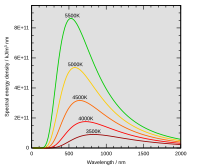
Photo from wikipedia
Recent progress in organic thermoelectric generators has resulted in high performance through chemical control of the redox levels of organic semiconductors, but the scarcity of good candidates for soluble organic… Click to show full abstract
Recent progress in organic thermoelectric generators has resulted in high performance through chemical control of the redox levels of organic semiconductors, but the scarcity of good candidates for soluble organic n‐type materials limits the use of π‐leg structures consisting of complementary elements of p‐ and n‐type materials because of unbalanced transport coefficients that lead to power losses. A sol–gel technique with oxidation is demonstrated to be effective for the fabrication of smooth films of poly(nickel 1,1,2,2‐ethenetetrathiolate), P(MX[Niett]), which is known as an insoluble material. By controlling the annealing temperature, a maximum n‐type power factor of 10.1 μW m−1 K−2 at 100 °C (Seebeck coefficient of −35.4 μV K−1 and electrical conductivity of 80.3 S cm−1) is demonstrated. Chemical and electronic structures of P(MX[Niett]) thin films are explored based on changes in optical absorption, ultraviolet, and X‐ray photoelectron spectroscopies to understand the origin of the high atmospheric stability. Analysis indicates that the stability arises from electronic states of the doped state that satisfy a balance with the redox potential of the air components and that stability under repeated redox reactions is an important factor for obtaining the n‐type organic thermoelectric materials that are highly stable in air.
Journal Title: Advanced Electronic Materials
Year Published: 2020
Link to full text (if available)
Share on Social Media: Sign Up to like & get
recommendations!